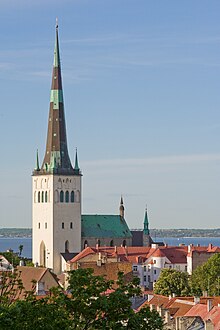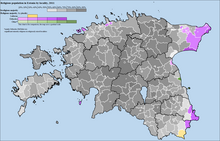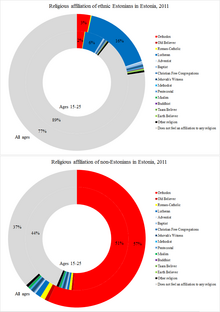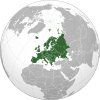爱沙尼亚宗教

爱沙尼亚历史上和传统上是一个基督新教路德宗国家[3][4][5],然而,爱沙尼亚是世界上“宗教信仰比例低”的国家之一,只有14%的人宣称宗教是其他们的日常生活重要组成部分。 [6]
爱沙尼亚宗教人口主要是基督徒,宗派大都属于路德宗和正教会。[7]在苏联的无神论政策下,“大多数家庭的宗教传统链条被打破”。[4][8]第二次世界大战前,爱沙尼亚约有80%的新教基督徒 ;属于路德宗。
在2001年至2011年的人口普查中,正教会信仰人数超越了路德宗,成为该国最大的基督宗教教派。然而,路德宗仍然是爱沙尼亚人中最受欢迎的宗教教派(11%是路德教派),正教会主要由的斯拉夫族裔(约占45%)所信奉。根据塔尔图大学指出,不信教的爱沙尼亚人不一定是无神论者,新异教主义、佛教徒和印度教徒宣称自己是“不信教”的人。[9]
历史
[编辑]

公元十三世纪,条顿骑士团把基督宗教传进了爱沙尼亚,在宗教改革前,爱沙尼亚地区主要教会为天主教。在宗教改革期间,爱沙尼亚福音路德教会变成主要教会。[10] 在第二次世界大战之前,爱沙尼亚约有80%是新教基督徒,绝大多数属于路德教派,也有归正宗及其他新教教派。Robert T. Francoeur和Raymond J. Noonan写道:“1925年,教会与国家分离,但宗教教育仍在学校教授,牧师在塔尔图大学神学院受训。随著苏联的占领和苏联反宗教立法的执行,基督新教教会失去了三分之二以上的神职人员,教会财产被国有化,神学院被关闭。爱沙尼亚许多教堂1941年至1944年在德国占领爱沙尼亚时被摧毁。苏联解体后,反宗教的法律被废除。[11]
人口统计
[编辑]不到三分之一的爱沙尼亚人有宗教信仰; 其中大部分是正教会(主要是斯拉夫族裔)或路德宗教派。还有一些少数其他宗教教派:穆斯林,犹太教和佛教。
人口统计
[编辑]| 宗教教派 | 2000[12] | 2011[1] | ||
|---|---|---|---|---|
| 人数 | % | 人数 | % | |
| 正教会 | 143,554 | 12.80 | 176,773 | 16.15 |
| 路德宗 | 152,237 | 13.57 | 108,513 | 9.91 |
| 浸信宗 | 6,009 | 0.54 | 4,507 | 0.41 |
| 天主教 | 5,745 | 0.51 | 4,501 | 0.41 |
| 耶和华见证人 | 3,823 | 0.34 | 3,938 | 0.36 |
| 旧礼仪派 | 2,515 | 0.22 | 2,605 | 0.24 |
| 公理会 | 223 | 0.02 | 2,189 | 0.20 |
| 爱沙尼亚本土原始信仰(Maausk) | 1,058 | 0.09 | 1,925 | 0.18 |
| 爱沙尼亚本土原始信仰(Taara faith) | 1,047 | 0.10 | ||
| 五旬节运动 | 2,648 | 0.24 | 1,855 | 0.17 |
| 穆斯林 | 1,387 | 0.12 | 1,508 | 0.14 |
| 基督复临安息日会 | 1,561 | 0.14 | 1,194 | 0.11 |
| 佛教 | 622 | 0.06 | 1,145 | 0.10 |
| 卫理宗 | 1,455 | 0.13 | 1,098 | 0.10 |
| 其他宗教 | 4,995 | 0.45 | 8,074 | 0.74 |
| 无宗教 | 450,458 | 40.16 | 592,588 | 54.14 |
| 未表态 | 343,292 | 30.61 | 181,104 | 16.55 |
| 全部1 | 1,121,582 | 100.00 | 1,094,564 | 99.00 |
1Population, persons aged 15 and older.
各种族宗教
[编辑]| 种族 | 总人口数[13] | 正教会 | 路德宗 | 浸信宗 | 天主教 | 耶和华见证人 | 旧礼仪派 | 五旬节运动 | 穆斯林 | 佛教 | 爱沙尼亚本土原始信仰 | 其他基督徒 | 其他宗教 | 无宗教或未表态 | |||||||||||||
|---|---|---|---|---|---|---|---|---|---|---|---|---|---|---|---|---|---|---|---|---|---|---|---|---|---|---|---|
| N | % | N | % | N | % | N | % | N | % | N | % | N | % | N | % | N | % | N | % | N | % | N | % | N | % | ||
| 爱沙尼亚族 | 902,547 | 20,585 | 2.28 | 104,691 | 11.5 | 3,648 | 0.4 | 1,314 | 0.14 | 1,982 | 0.2 | 194 | 0.02 | 1,086 | 0.1 | 148 | 0.0 | 978 | 0.1 | 2,941 | 0.3 | 4,439 | 0.49 | 2,759 | 0.3 | 605,822 | 67.12 |
| 俄罗斯族 | 326,235 | 142,971 | 43.8 | 862 | 0.26 | 515 | 0.15 | 560 | 0.17 | 1,322 | 0.4 | 2,368 | 0.72 | 512 | 0.15 | 107 | 0.03 | 114 | 0.03 | — | 1,344 | 0.41 | 687 | 0.21 | 140,223 | 42.9 | |
| 乌克兰族 | 22,573 | 10,816 | 47.9 | 99 | 0.43 | 155 | 0.68 | 121 | 0.53 | 330 | 1.46 | — | 147 | 0.65 | — | — | — | 252 | 1.1 | 159 | 0.7 | 9,416 | 41.7 | ||||
| 保加利亚人 | 12,579 | 6,188 | 49.1 | 44 | 0.34 | 44 | 0.34 | 598 | 4.7 | 55 | 0.43 | — | 22 | 0.17 | — | — | — | 55 | 0.43 | 45 | 0.35 | 5,188 | 41.2 | ||||
| 芬兰人 | 7,589 | 818 | 10.7 | 1,948 | 25.6 | 36 | 0.47 | 33 | 0.43 | 108 | 1.4 | 7 | 0.1 | 21 | 0.27 | — | 9 | 0.11 | 8 | 0.1 | 45 | 0.59 | 29 | 0.38 | 4,131 | 54.4 | |
| 塔塔尔族 | 1,993 | 174 | 8.7 | 5 | 0.25 | 4 | 0.2 | — | 5 | 0.25 | — | 7 | 0.35 | 604 | 30.3 | — | — | 8 | 0.4 | 8 | 0.4 | 1,067 | 53.5 | ||||
| 拉脱维亚人 | 1,764 | 254 | 14.3 | 221 | 12.5 | 9 | 0.5 | 140 | 7.9 | 7 | 0.39 | 3 | 0.17 | 6 | 0.34 | — | — | — | 13 | 0.73 | 8 | 0.45 | 954 | 54 | |||
| 德裔 | 1,544 | 274 | 17.7 | 203 | 13.1 | 26 | 1.68 | 78 | 5 | 14 | 0.9 | — | 6 | 0.38 | — | — | — | 31 | 2 | 15 | 0.97 | 734 | 47.4 | ||||
调查
[编辑]- 盖洛普 2006-2008年的一项调查显示,14%的爱沙尼亚人表示“宗教是你日常生活的重要组成部分”这个问题是积极的,这在所有调查的143个国家中是最低的。[14]
- 2015年皮尤研究中心的一项调查发现,爱沙尼亚人口中有51%宣称是基督徒,45%是无宗教的(这个类别包括无神论者,不可知论者和表态“没有一定信仰”的人),而2%属于其他信仰。[15]基督徒中东正教25%,路德宗20%,其他基督徒的5%和天主教1%。[16]非宗教人士有9%无神论者,1%不可知论者和35%“没有什么特定信仰”。[17]
- 国际社会调查计画2015年调查发现,爱沙尼亚人口有57.0%宣布属于一个基督宗教教派(东正教27.6%,路德宗26.0%,其他基督宗派3.3%),只有38.9%的人宣称没有宗教信仰。[18]
参见
[编辑]参考注释
[编辑]- ^ 1.0 1.1 1.2 PC0454: AT LEAST 15-YEAR-OLD PERSONS BY RELIGION, SEX, AGE GROUP, ETHNIC NATIONALITY AND COUNTY, 31 DECEMBER 2011. Statistics Estonia. 2011-12-31 [2014-01-09]. (原始内容存档于2017-10-14).
- ^ PHC 2011: over a quarter of the population are affiliated with a particular religion. Statistics Estonia. 2013-04-29 [2014-01-09]. (原始内容存档于2017-11-24).
- ^ Ivković, Sanja Kutnjak; Haberfeld, M.R. Measuring Police Integrity Across the World: Studies from Established Democracies and Countries in Transition. Springer. 2015-06-10: 131. ISBN 9781493922796 (英语).
Estonia is considered Protestant when classified by its historically predominant major religion (Norris and Inglehart 2011) and thus some authors (e.g., Davie 2003) claim Estonia belongs to Western (Lutheran) Europe, while others (e.g., Norris and Inglehart 2011) see Estonia as a Protestant ex-Communist society.
- ^ 4.0 4.1 引用错误:没有为名为
MarshallCavendish2010的参考文献提供内容 - ^ Rausing, Sigrid. History, Memory, and Identity in Post-Soviet Estonia: The End of a Collective Farm. Oxford University Press. 2004: 96. ISBN 9780199263189 (英语).
Protestantism has done much to inform the moral world view of the Estonians, particularly the process of distinguishing themselves from the Russians.
- ^ Estonians least religious in the world. EU Observer. 2009-02-11 [2014-01-09]. (原始内容存档于2016-07-05).
- ^ Eestis on 90 usuvoolu: lilla leegi hoidjad, kopimistid, tulekummardajad... [Estonia has 90 religious affiliations: Keepers of the violet flame, Kopimists, Fire worshipers]. Postimees. 2013-04-29 [2014-01-09]. (原始内容存档于2017-07-26).
- ^ Ringvee, Ringo. Is Estonia really the least religious country in the world?. The Guardian. 2011-09-16.
For this situation there are several reasons, starting from the distant past (the close connection of the churches with the Swedish or German ruling classes) up to the Soviet-period atheist policy when the chain of religious traditions was broken in most families. In Estonia, religion has never played an important role on the political or ideological battlefield. The institutional religious life was dominated by foreigners until the early 20th century. The tendencies that prevailed in the late 1930s for closer relations between the state and Lutheran church [...] ended with the Soviet occupation in 1940.
- ^ Martin Noorkõiv (6 November 2012). "The Estonian Atheist Experiment" (页面存档备份,存于互联网档案馆). University of Tartu Blog.
- ^ Francoeur, Robert T.; Noonan, Raymond J. The Continuum Complete International Encyclopedia of Sexuality. A&C Black. 2004: 361. ISBN 9780826414885.
The dominant religion in Estonia is Evangelical Lutheranism. Estonians were Christianized by the Teutonic Knights in the 13th century. During the Reformation, Lutheranism spread, and the church was officially established in Estonia in 1686.
- ^ Francoeur, Robert T.; Noonan, Raymond J. The Continuum Complete International Encyclopedia of Sexuality. A&C Black. 2004: 361. ISBN 9780826414885.
It was not until 1998 that the state's religious policies became tolerant, and by 1990, repressive legislation was annulled.
- ^ PC231: POPULATION BY RELIGIOUS AFFILIATION AND ETHNIC NATIONALITY. Statistics Estonia. 2000-03-31 [2014-01-09]. (原始内容存档于2018-07-19).
- ^ PC0428: POPULATION BY ETHNIC NATIONALITY, SEX AND PLACE OF RESIDENCE, 31 DECEMBER 2011. [2020-09-13]. (原始内容存档于2017-10-18).
- ^ Crabtree, Steve; Pelham, Brett. What Alabamians and Iranians Have in Common. Gallup. 2009-02-09 [2010-02-21]. (原始内容存档于2017-07-23).
- ^ ANALYSIS. Religious Belief and National Belonging in Central and Eastern Europe (PDF). 2017-05-10 [2017-05-12]. (原始内容 (PDF)存档于2017年5月13日).
- ^ Religious Belief and National Belonging in Central and Eastern Europe: National and religious identities converge in a region once dominated by atheist regimes. [2018-02-09]. (原始内容存档于2017-05-10).
- ^ Religious Belief and National Belonging in Central and Eastern Europe: 1. Religious affiliation (页面存档备份,存于互联网档案馆); Pew Research Center, 10 May 2017
- ^ Country specific religious affiliation or denomination: Estonia - weighted. International Social Survey Programme: Work Orientations IV - ISSP 2015. 2015 [2018-02-09]. (原始内容存档于2019-12-12) –通过GESIS.

